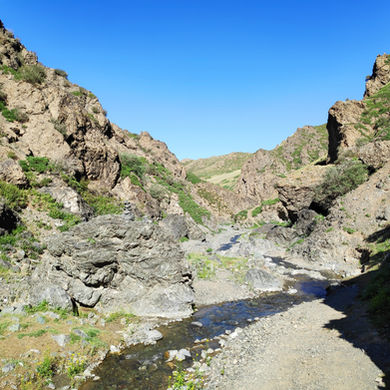
The Gobi

Highlights

About Gobi
Not so cold and not so deserted...
Known as the coldest desert in the world, the Gobi is surprisingly alive with lots of livestock grazing, colorful plants and lots of birds and small mamals rushing about.
As a surprise to most people, the Gobi is actually not a very sandy desert. The soil is mostly hard and rocky, though you do find smaller and larger sand dunes as well.
Tours to the Gobi follow the main roads, of which only roughly half are paved. The route to south follows the road from UB to Dalanzadgad, whereas back north you usually pass into the central areas via Ongii and take a look at Karakorum before heading back to UB.
Baga Gazriin Chuluu
Literally translated "little rock land", Baga Gazriin Chuluu features impressive canyons, the ruins of a hidden temple and a rock spring.


Tsagaan Suvraga
Known as "the white stupa" for some reason, this clay cliff overlooking south Gobi is nothing like white. Mineral deposits show shades of red, purple and green across the cliff and the moonscape below.
Yolin Am
In the south of the Gobi, there's one of the largest national parks in Mongolia, the "Gurvan Saikhan" mountain range. Inside, there are numerous valleys, and Yolin Am is the most famous of them all. Its high wall keep the sun out most of the day, so even late in summer the stream inside is frozen to ice. Vultures nest high above your heads and small large-eared rodents wizz about your feet as you explore the depth of the gorge.


Khongorin Els - The Singing Dunes
With a length of over 100km and a height of over 200m, this is the second highest dune of Mongolia. The sands ripple off the top, creating a humming sound that gives the dune its name. Despite being only 120km from Yolin Am, the drive is quite challenging offroad and takes a while. Ride camels into the dunes, then climb to the top and enjoy the sunset.
Bayanzag - The flaming cliff
Pretty much in the middle of the Gobi provinces lies Bayanzag. This is the site where the first fully fossilized dinosaur eggs where discovered. Another clay cliff, mineral deposits give the entire area a red hue. During sunset, you will understand why it is called the flaming cliff.


Ongiin Khiid
Located on the Ongii river, hidden in a beautiful valley , Ongii Monastery was a sprawling buddhist monastery until it was destroyed in the 1930s and all the monks executed. Today it serves as a reminder of those days, as well as a place to rest up, enjoy a stroll and a leisurely day.

Activities

Camel Riding
They're large, they're furry and they are comfy. If you never rode a 2-humped camel, it should be on your bucket list.

Horse Riding
Mongolian horses are smaller than their western relatives, but easier to ride, stronger and have more stamina. Ride for an hour along the tour or insert a multi-day horse ride in your itinerary.
Hiking
Therer's always a little hiking. Depending on your fitness, you can do more or less of it along the way. However, let us know if you want to spend a full day or two on foot.

Visiting Nomads
Nomads still move 4 times per year, a whole family in a single Ger. Modern technology helps, but it's basically stil lthe same lifestyle as over the past centuries.


CHECK OUT OUR
Want to explore more?
Add other regions to your journey. A Gobi trip neatly ties up very well with a trip to the North, and since you're passing through central anyways, you might as well have a closer look...
Take a look at the region pages or get in touch directly to start planning your Mongolian adventure.









